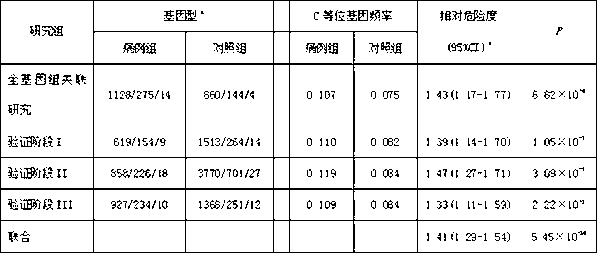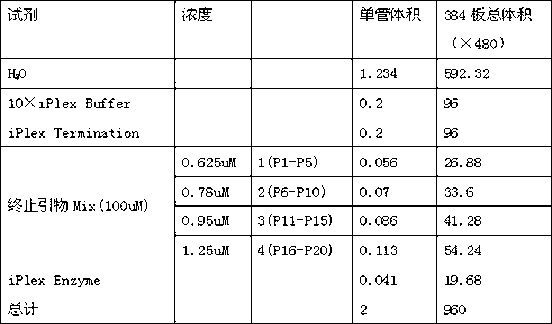Single nucleotide polymorphism site relevant to susceptibility of prostate cancer and application of single nucleotide polymorphism site
A single nucleotide polymorphism, prostate cancer technology, applied in the direction of DNA / RNA fragment, recombinant DNA technology, etc., can solve the problem of no prostate cancer related reports
- Summary
- Abstract
- Description
- Claims
- Application Information
AI Technical Summary
Problems solved by technology
Method used
Image
Examples
Embodiment 1
[0014] The genotyping of the single nucleotide polymorphism rs817826 was performed by extracting the subject's genomic DNA, and the individuals whose rs817826 base was C were the susceptible population of prostate cancer. The specific method is:
[0015] 1. Extraction of Genomic DNA
[0016] All subjects were drawn 2-3ml of peripheral venous blood, and genomic DNA was extracted with QIAamp Blood Mini Kit250 (QIAGEN, Germany) kit, and stored at -20°C.
[0017] 2. SNP genotyping
[0018] According to the sequence information of the SNP, PCR reactions and single-base extension primers were designed using Sequenom’s primer design software MassARRAY Assay Design 3.1 (Sequenom, Inc., San Diego, CA), and synthesized at Bioengineering (Shanghai) Co., Ltd. The synthesized primers were subjected to PCR reaction with the sample DNA, and the mixed reaction products were subjected to SNP genotyping on the Sequenom iPLEX instrument. The specific experimental process is as follows:
[00...
Embodiment 2
[0043] Correlation between SNP in 9q31.2 genetic region and prostate cancer
[0044] In this study, through a multi-stage case-control study, it was shown that the SNP in the 9q31.2 genetic region was associated with prostate cancer. The study took 4484 cases of prostate cancer patients as the research group, and 8934 cases of non-tumor patients as the control group. Genomic DNA was extracted from all subjects and stored at -20°C.
[0045] The results of the multi-stage case-control study showed that those whose rs817826 base is C have a high risk of prostate cancer, as shown in the following table:
[0046]
[0047] a TT / TC / CC
[0048] Examples of the utility of the invention:
[0049] (1) According to the method of the present invention for determining the susceptible population of prostate cancer by the polymorphic site rs817826, the
[0050] Screening of people without clinical symptoms of tumors can be used for auxiliary diagnosis of prostate cancer and judgment ...
PUM
 Login to View More
Login to View More Abstract
Description
Claims
Application Information
 Login to View More
Login to View More - R&D
- Intellectual Property
- Life Sciences
- Materials
- Tech Scout
- Unparalleled Data Quality
- Higher Quality Content
- 60% Fewer Hallucinations
Browse by: Latest US Patents, China's latest patents, Technical Efficacy Thesaurus, Application Domain, Technology Topic, Popular Technical Reports.
© 2025 PatSnap. All rights reserved.Legal|Privacy policy|Modern Slavery Act Transparency Statement|Sitemap|About US| Contact US: help@patsnap.com



